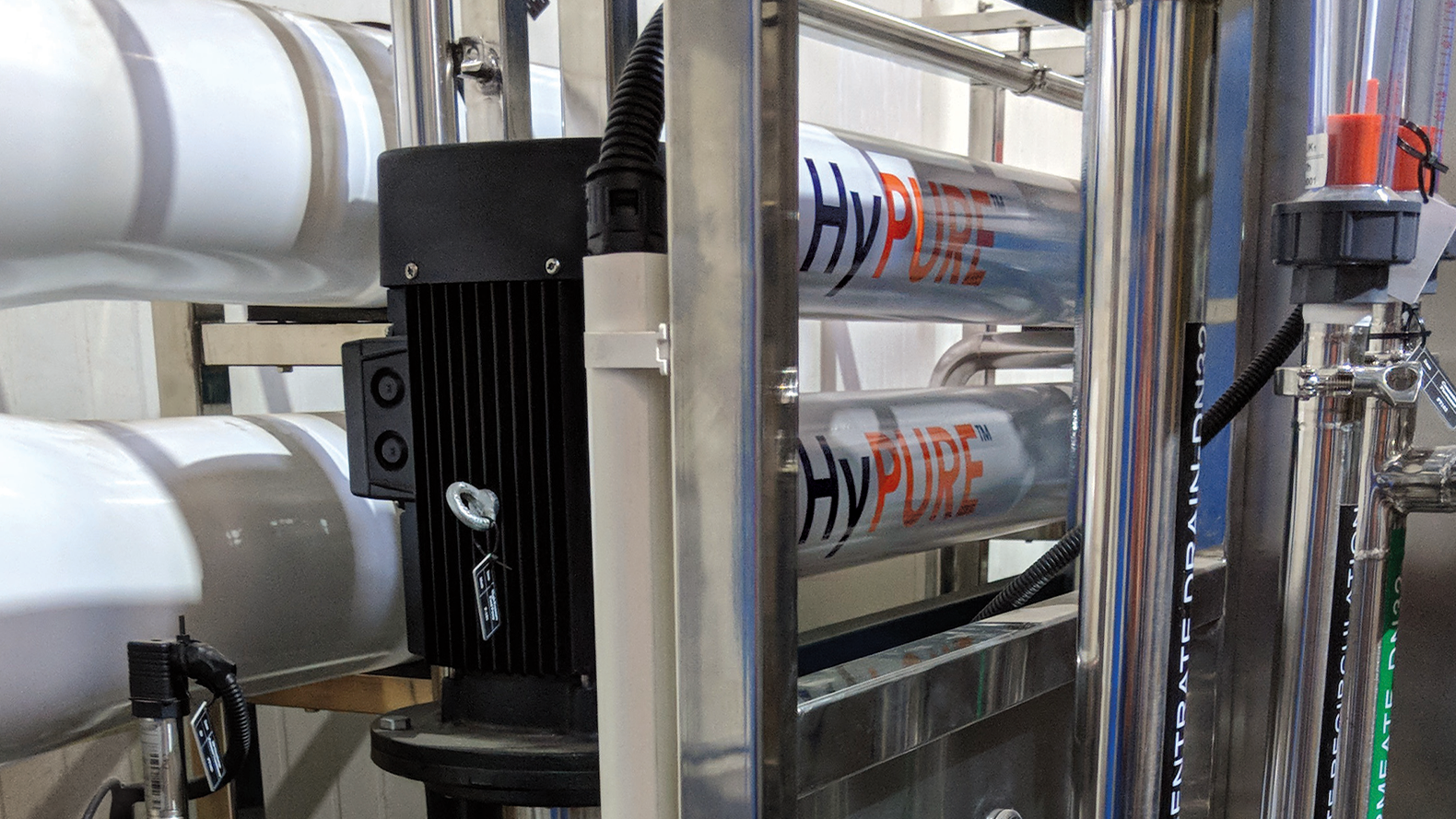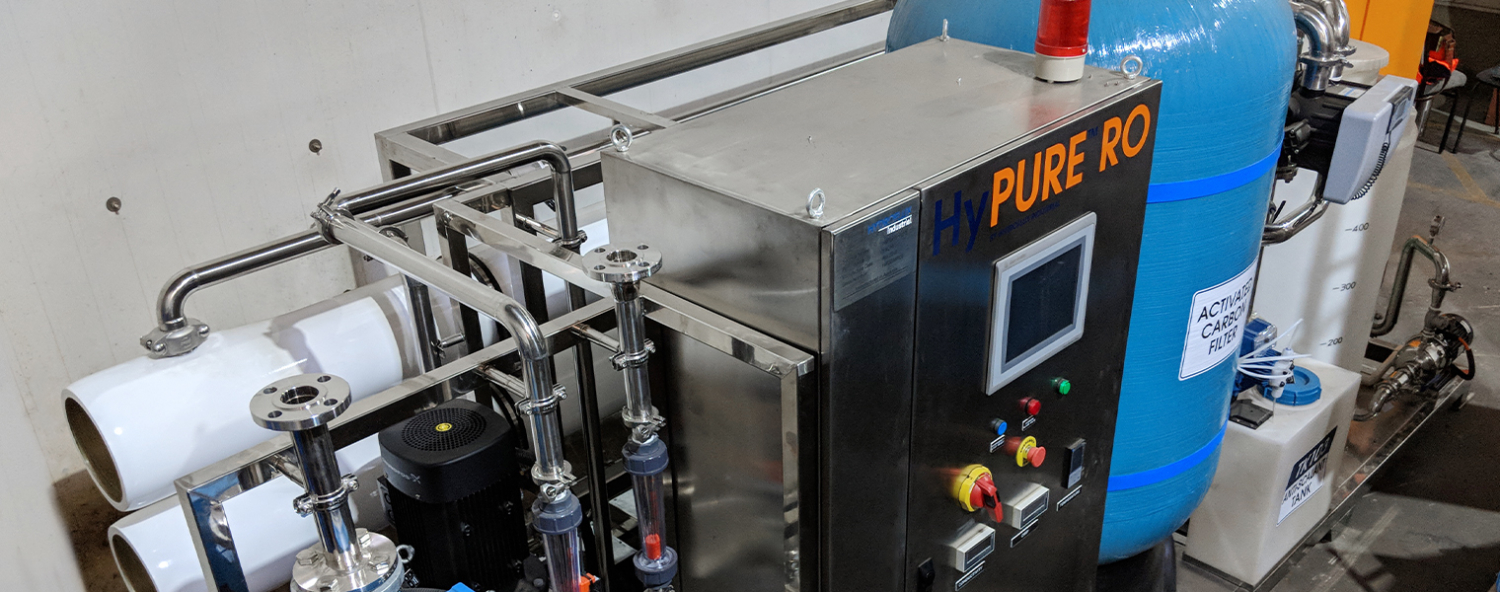
HyPURE® RO Systems
Currently, less than 1% of all water found on our planet is suitable for human consumption.

Through reverse osmosis, humanity have been able secure suitable water for drinking and also for industrial processes from the vast volumes of seawater and brackish groundwater. Hydroflux® are a global leader in the supply of seawater desalination systems.
Hydroflux® design and supply a range of robust HyPURE® seawater and saline brackish water reverse osmosis systems. These systems are designed to meet the most stringent requirements for production of high purity industrial process water, as well as potable water.
One of the major challenges providing clean water from seawater to those who most desperately need it is the high energy requirement to desalinate seawater. Hydroflux® offer a range of unique energy recovery solutions for small and medium HyPURE® plants, producing as little as 5m3/D. Our unique design feature ensures Hydroflux® provide our customers with the most energy efficient solution available on the market, no matter how big or small their system is.
More information on our HyPURE® range of Reverse Osmosis desalination systems can be found below.
Find out more
The Hydroflux® HyPURE® range of seawater reverse osmosis systems’ low energy design and exceptional performance in industrial applications are just some of the reasons why these systems are so popular for potable and process water production.
The HyPURE® range of seawater RO systems can be utilised in a wide variety of applications.
- Production of potable and process water from seawater and high TDS brackish water supplies for industrial applications
- Further concentration of HyPURE RO brine as part of zero liquid discharge process
- Production of demineralised water for steam boiler make-up
- Concentration of landfill leachate
- Treatment of waste to meet strict environmental discharge standards
- Zero liquid discharge from industrial processes
Our expertise in the operation of pre-treatment stages also gives Hydroflux® a unique edge in the industry.
We design the complete system from inlet to outlet to effectively manage water sources with the highest risk of membrane fouling. Our in depth understanding of managing complex feed streams leads to extended membrane life, low energy consumption, minimum downtime and maximum return on investment.
The Hydroflux® HyPURE® range of brackish water reverse osmosis systems’ low energy design and exceptional performance in industrial applications are just some of the reasons why these systems are so popular for industrial water and wastewater treatment.
Some of the key features of the HyPURE® range of seawater and high TDS brackish water RO systems are:
- VSD drives for all high pressure pumps, to optimise energy consumption and plant recovery regardless of variable TDS and temperature conditions
- Energy Recovery Devices, even on the smallest plants (5m3/D)
- Robust, cost effective plant design all manufactured to Australian standards
- Advanced instrumentation and monitoring to facilitate forecasting of system maintenance and membrane life
- Remote plant control and troubleshooting support through HyCONNECT®
- Utilisation of world leading HydraSCALE® RO anti-scalants to optimise plant performance
- Containerised or modular skid mounted solutions for true plug-and-play installation
- Integration of the HyPURE® plant with a wide range of pre-treatment solutions designed and supplied in-house by Hydroflux®.
Hydroflux® also offer the HyPURE® range in ultra high pressure RO, disc stack RO. Hydroflux also offer a range of additional brine treatment solutions for zero liquid discharge applications.
Our expertise in wastewater gives us a unique edge in the industry, as we design our systems to manage water sources with the highest risk of scaling and biofouling. This conservative approach leads to extended membrane life, low energy consumption, minimum downtime and maximum recovery.
Frequently asked Questions – Hydroflux® HyPURE® – Industrial Seawater Reverse Osmosis systems
What is the capacity of the range of HyPURE® Reverse Osmosis systems?
The HyPURE® range a individually designed to suit customer requirements, the treatment capacity can range from <5m3/D up to and above 50,000m3/D. We have standard sizes that we manufacture, but due to the variability of the site conditions, feed water quality, available space in the plant each solution must be tailored to suit.
What type of maintenance is required on a HyPURE® RO?
HyPURE® RO’s are designed for extended maintenance free operating periods. Typically only infrequent checking of chemicals, cartridge filter replacement and calibration of probes is necessary, as all critical operating data is continuously recorded and saved to customers HyDATA accounts. Operation of the plant can also be controlled remotely through the HyCONNECT® system. A routine Clean in Place (CIP) is necessary to maximise membrane life however this process is made very simple by our online step-by-step CIP walkthrough, which minimises operator error in what would be a complex task on traditional RO plants. Plants utilising energy recovery or solar energy sources will also different maintenance requirements to those without.
Does the HyPURE® RO require a lot of power?
Generally speaking, seawater RO systems require a lot more power than low pressure brackish water RO systems. This is one of the main advantages of recycling industrial wastewater compared with producing process water from seawater sources. The Hydroflux® HyPURE® range of RO systems require lower energy requirements compared with typical competitor systems. Energy requirements can also be further off-set by utilisation of energy recovery devices as well as solar cells.
What is an energy recovery device?
An energy recovery device is typically a system based on a pelton wheel or pressure exchanger which transfers the residual high pressure energy from the concentrated brine stream into the feed. Although the transfer efficiency of the ERD is generally very high (>97%), the total energy recovery is lower. This is because the brine stream flow is only 60% of the feed flow, so additional energy is required to boost the remaining 40%. The RO high pressure pump must also make-up for any pressure losses in the pipework as the feed water passes through the RO plant and out to the ERD.
What is the smallest system that can utilise an energy recovery device?
Traditionally, it is not possible to utilise an energy recovery device on plants producing less than 100m3/D of treated water. Hydroflux® HyPURE® plants can utilise energy recovery devices on plants producing as little as 5m3/D. This is particularly advantageous for remote plants, where power may only be available via diesel which can be costly to deliver to site.
Can the HyPURE® RO systemse handle variable loads of dissolved solids?
The Reverse Osmosis systems variable pollutant loads if the feed pump frequency can be reduced or increased sufficiently to facilitate it. In some zero liquid discharge, or leachate treatment applications where the TDS varies so significantly, a specially designed pumping system may be necessary. Hydroflux® have experience in specialised RO system capable of handling these fluctuating loads.
What is the highest operating pressure obtainable in a Reverse Osmosis system?
Conventional seawater thin film composite spiral wound RO systems can operate up to 80 BarG. More advanced spiral wound membranes are now available to allow operating pressures up to 120 BarG. In addition to this, Hydroflux® offers tubular flat disc RO solutions capable of ultra-high pressure operation, up to 150 BarG which are ideal in zero liquid discharge and leachate treatment applications.
Can the HyPURE® RO system handle suspended or colloidal solids?
Introduciton of any suspended or colloidal solids to RO systems should be avoided, as these rapidly foul the RO membranes. If suspended or colloidal solids are present in the feedwater, the upfront use of HyDAF/FlooDAF or HyPURE MMF or UF should be considered.
The level of pre-treatment required will often depend on suspended solids and or silt density index (SDI) or membrane fouling index (MFI) tests performed on the feed water. Through our in depth knowledge of pre-treatment processes, Hydroflux® have the required level of expertise to assist our clients to develop an overall water treatment strategy which minimises the total cost of ownership.
Can the HyPURE® RO system handle iron, manganese and other metals in the feed water?
RO systems, can handle trace levels of metals within the feed water. However, to avoid the formation of metal oxides and metal hydroxides extreme care must be taken to prevent the introduction of dissolved oxygen (through head space in tanks and other areas) to maintain these elements in a reduced state. Quite often this is not practical and a HyPURE MMF with Manganese Greensand media, HySEP clarifier or HyDAF/FlooDAF is necessary up front to avoid fouling of the RO system.
Do I need any treatment after a HyPURE® RO system?
In many instances, additional treatment is required even after an RO system. Despite RO permeate being very low in dissolved salts, trace levels of dissolved organic carbon (DOC) provide enough food for slow growth of organisms within the treated water permeate pipe network. Often as a minimum, residual disinfectants such chlorine, chlorine dioxide, chloramine or ozone are introduced. In many instances, hardness and bicarbonate alkalinity is also added into the permeate to protect copper and cast iron pipe networks from dissolving in RO permeate. Additional post treatment involving UV disinfection, membrane degassing, continuous electro deionization or Ion exchange are also utilised to produce higher purity water levels for specialised industrial processes.
Is it possible to maintain a clean environment in the RO permeate without the use of residual disinfectants?
Yes, this is common in hygienic applications where process water is going into products which can not tolerate chlorine, e.g. semi-conductor/microelectronics, beverages, pharmaceutical products, cosmetics or in the production of nutritional powders. To maintain a hygienic environment in the product pipework free from microorganisms, hygienic grade stainless or other smooth walled materials are required. The pipework must be routinely cleaned, either by high temperatures (up to 85 C) or infrequent chemical washes.
Hydroflux® design HyPURE plants which can be entirely heat sterilised, including the use of sanitary heat sanitisable RO membranes to ensure the complete treatment plant is free from microorganisms. Treated water pipework may also need to be continuously flushed, to prevent growth within pipework dead legs through the implementation of continuous recirculation and polishing of the product water supply loop. The Hydroflux team specialises in the design of hygienic plants
